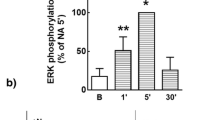Abstract
We have shown that glucocorticoids induce the appearance of β2-adrenergic receptors in membranes of the ductus deferens smooth muscle cell line (DDT1 MF-2). A concomitant increase in isoproterenol stimulated adenylate cyclase activity in the absence of exogenously applied GTP was observed as was a significantly increased (p < 0.05) sensitivity of the adenylate cyclase system to exogenously applied GTP. However, no significant difference in the maximal velocity of adenylate cyclase between control and steroid treatment was measurable in the presence of sodium fluoride. Induction of β2-adrenergic receptors in DDT1 MF-2 cells is correlated with the presence of steroid receptors (androgen and glucocorticoid) in the cells since estrogens and progesterones had no effect on receptor levels. Finally, utilizing dense amino acid labeling of cells to measure old versus newly synthesized receptor sites by a density shift method, we have documented that glucocorticoid induction of β2-adrenergic receptors involves synthesis of new receptor protein.
Similar content being viewed by others
References
Norris JS: Tumors of the accessory sex glands of male Syrian hamsters and hormone action. In: Spring-Mills E, Hafez ESE (eds), Male Accessory Sex Glands, Elsevier/North Holland Biochemical Press, 1980, pp 610–616.
Syms AJ, Norris JS, Smith RG: Proliferation of a highly androgen-sensitive cloned cell line (DDT1 MF-2) is regulated by glucocorticoids and modulated by growth on collagen. In Vitro 19:929–936, 1983.
Smith RG, Syms AJ, Norris JS: Differential effects of androgens and glucocorticoids on regulation of cell growth and androgen receptor concentration. J Steroid Biochem 20:277–281, 1984.
Syms AJ, Norris JS, Smith RG: Androgen stimulated elevation in androgen receptor levels is inhibited by the synthetic glucocorticoid triamcinolone acetonide. Biochem Biophys Res Commun 116:1020–1025, 1983.
Norris JS, Gartner DJ, Brown F, Popovich K, Cornett LE: Characteristics of an adenylate cyclase coupled β2-adrenergic receptor in a smooth muscle cell line. J Recept Res 3:623–645, 1983.
Cornett LE, Norris JS: Characterization of the α1-adrenergic receptor subtype in a smooth muscle cell line. J Biol Chem 257:694–697, 1982.
Cornett LE, Ball DW, Norris JS: α1-adrenergic receptors of a smooth muscle cell line: guanine nucleotides do not regulate agonist affinities. J Recept Res 2:601–610, 1982.
Norris JS, Cornett LE, Kohler PO, MacLeod SL, Syms AJ, Smith RG: Glucocorticoids induce a 29000 Mr protein in DDT1 MF-2 smooth muscle cells but not in the DDT1 MF-2 GR glucocorticoid resistant variant. Molec Cell Biochem 68:79–85, 1985.
Firestone GL, Payvar F, Yamamoto KR: Glucocorticoid regulation of protein processing and compartmentalization. Nature 300:221–225, 1982.
Vannice JL, Taylor JM, Ringold GM: Glucocorticoidmediated induction of α1-acid glycoprotein: evidence for hormone regulated RNA processing. Proc Natl Acad Sci USA 81:4241–4245, 1984.
Karin M, Haslinger A, Holtgreve H, Richards RI, Krauter P, Westphal HM, Beato N: Characterization of DNA sequences through which cadmium and glucocorticoid hormones induce human metallothionein-IIA gene. Nature 308:513–519, 1984.
Shinomiya T, Scherer G, Schmid W, Zentgraf H, Schultz G: Isolation and characterization of the rat tyrosine amino transferase gene. Proc Natl Acad Sci USA 81:1346–1350, 1984.
Fantus IG, Saviolakis GA, Hedo JA, Gorden P: Mechanism of glucocorticoid-induced increase in insulin receptors of cultured human lymphocytes. J Biol Chem 257:8277–8283, 1983.
Knutson VP, Ronnett GV, Lane MD: Control of insulin receptor levels in 3T3 cells: effect of insulin-induced downregulation and dexamethasone-induced upregulation rate of receptor inactivation. Proc Natl Acad Sci USA 79:2822–2826, 1982.
Baker JB, Barsh GHS, Carney DH, Cunningham DD: Dexamethasone modulates binding and action of epidermal growth factor in serum free cell culture. Proc Natl Acad Sci USA 75:1882–1886, 1978.
Fraser CM, Venter JC: The synthesis of β-adrenergic receptors in cultured human lung cells: induction by glucocorticoids. Biochem Biophys Res Commun 94:390–397, 1980.
Cheng JB, Goldfien A, Ballard PL, Roberts JM: Glucocorticoids increase pulmonary β-adrenergic receptors in fetal rabbit. Endocrinology 107:1646–1648, 1980.
Mano K, Akbarzadeh A, Townley RG: Effect of hydrocortisone on β-adrenergic receptors in lung membranes. Life Sci 25:1925–1930, 1979.
Stadel J, Strulovici B, Nambi P, Lavin TN, Briggs MM, Caron MG, Lefkowitz RJ: Desensitization of the β-adrenergic receptor of frog erythrocytes: recovery and characterization of the downregulated receptors in sequestered vesicles. J Biol Chem 258:3032–3038, 1983.
Strulovici B, Stadel JM, Lefkowitz RJ: Functional integrity of desensitized β-adrenergic receptors. Internalized receptors reconstitute catecholamine-stimulated adenylate cyclase activity. J Biol Chem 258:6410–6414, 1983.
Norris JS, Kohler PO: The coexistence of androgen and glucocorticoid receptors in the DDT1 cloned cell line. Endocrinology 100:613–618, 1977.
Bradford MM: A rapid and sensitive method for the quantitation of microgram quantities of protein utilizing the principle of protein-dye binding. Anal Biochem 72:248–254, 1973.
Benovic JL, Shorr RGL, Caron MG, Lefkowitz RJ: The mammalian β2-adrenergic receptor: purification and characterization. Biochemistry 23:4510–4518, 1984.
Salomon Y, Londos C, Rodbell M: A highly sensitive adenylate cyclase assay. Anal Biochem 58:541–546, 1974.
Reed BC, Lane MD: Insulin receptor synthesis and turnover in differentiating 3T3-Ll preadipocytes. Proc Natl Acad Sci USA 77:285–289, 1980.
Brown MS, Anderson RGW, Goldstein JL: Recycling receptors: the round trip itinerary of migrant membrane protein. Cell 32:663–667, 1985.
Gilman AG: G proteins and the dual control of adenylate cyclase. Cell 36:577–579, 1984.
Davies AD, Lefkowitz RJ: In vitro desensitization of β-receptors in human neutrophils. J Clin Invest 71:565–571, 1983.
Syms AJ, Norris JS, Smith RG: Autocrine regulation of growth. I: Glucocorticoid inhibition is overcome by exogenous platelet derived growth factor. Biochem Biophys Res Commun 122:68–74, 1984.
Norris JS, Cornett LE, Hardin JW, Kohler PO, MacLeod SC, Srivastava A, Syms JS, Smith RG: Autocrine regulation of growth. II: Glucocorticoids inhibit transcription of c-sis proto-oncogene specific RNA transcripts. Biochem Biophys Res Commun 122:124–128, 1984.
Syms AJ, Norris JS, Panko WB, Smith RG: Mechanism of androgen receptor augmentation: analysis of receptor synthesis and degradation by the density-shift technique. J Biol Chem 260:455–461, 1985.
Author information
Authors and Affiliations
Rights and permissions
About this article
Cite this article
Norris, J.S., Brown, P., Cohen, J. et al. Glucocorticoid induction of β-adrenergic receptors in the DDT1 MF-2 smooth muscle cell line involves synthesis of new receptor. Mol Cell Biochem 74, 21–27 (1987). https://doi.org/10.1007/BF00221909
Received:
Issue Date:
DOI: https://doi.org/10.1007/BF00221909



